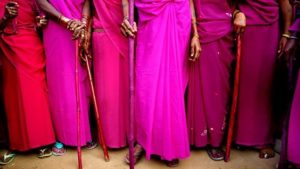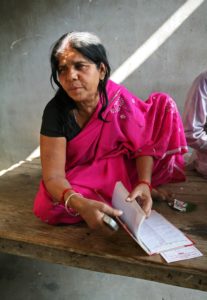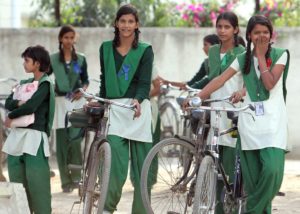If Uttar Pradesh were a country, it would be the 5th most heavily populated state –as is currently Brazil-, but also one of the poorest. This part of the Indian subcontinent is also one of the most politically unstable due to corruption and clashes between various religious groups and castes. As a consequence, it also holds one of the highest rates of violence. In a rapidly changing India, this huge region is facing difficulty in keeping up with the fast pace of globalisation that is encouraging growth within the country. Whilst the whole country was subject to an 8% growth rate between 2007-2011, Uttar Pradesh did not exceed 6% during this same period (de Jacquelot, 2014).
In a country where castes, arranged marriages, and honor are still ingrained in the society and its social mind-set, the emancipation of women is rendered difficult. However, things are changing, one of the leaders of the emancipation movements in the country has been Sampat Pal Devi. Originally from the Uttar Pradesh region in the Bundelkhand district and being raised in a large family, she is fighting for her cause to be heard.
marriages, and honor are still ingrained in the society and its social mind-set, the emancipation of women is rendered difficult. However, things are changing, one of the leaders of the emancipation movements in the country has been Sampat Pal Devi. Originally from the Uttar Pradesh region in the Bundelkhand district and being raised in a large family, she is fighting for her cause to be heard.
A feminist movement in India
 Sampat Pal Devi comes from a country where women, especially those from disadvantaged communities, are often limited to the private sphere. In order to preserve the honour of their family, a woman has to stay discrete, not show herself alone in public, and even less to politically align herself. Contrary to this, Sampat Pal Devi expresses herself, defends her ideas, and gathers support for her cause. Her movement, the “saris roses revolution”, also referred to as the “pink gang” (Gulâbî Gang), became known to the global media scene through its collective actions. Composed of millions of women and some men, the “gang” distinguishes itself by its traditional Indian garment, the pink coloured sari, that is one of the rare colours not associated with any prior movements in India. The founder of this movement is an example of emancipation for all women: married at twelve years old, pregnant at fifteen, and having been denied education, she is now fighting for the rights of all human beings, but in particular to stop women’s rights being disregarded.
Sampat Pal Devi comes from a country where women, especially those from disadvantaged communities, are often limited to the private sphere. In order to preserve the honour of their family, a woman has to stay discrete, not show herself alone in public, and even less to politically align herself. Contrary to this, Sampat Pal Devi expresses herself, defends her ideas, and gathers support for her cause. Her movement, the “saris roses revolution”, also referred to as the “pink gang” (Gulâbî Gang), became known to the global media scene through its collective actions. Composed of millions of women and some men, the “gang” distinguishes itself by its traditional Indian garment, the pink coloured sari, that is one of the rare colours not associated with any prior movements in India. The founder of this movement is an example of emancipation for all women: married at twelve years old, pregnant at fifteen, and having been denied education, she is now fighting for the rights of all human beings, but in particular to stop women’s rights being disregarded.
Achieving rural development through education, employment and empowerment of women and girls from rural communities
 The Pardada Pardadi Educational Society (the term“Paradada Pardadi” translates to ‘ great grand-parents” in Hindu) is one of the organisations that wish to change things in a region where public aid is not sufficient to satisfy the needs of the poverty-stricken population. Founded in 2000 by Viendra Singh, the NGO creates employment, support groups, and access to equipment, such as toilets and solar lanterns, to communities that lack opportunities. In particular, results have been impressive on the educational side. That said, the initiative has proved to be a great success and is constantly growing year by year: from numbering 45 girls in the year 2000, to currently bringing together more than 1200 young females. Every year, one girl who has attended school within the realms of the association is selected to continue her studies in an American university. In order to encourage the families to send their daughters to school, Pardada Pardadi gives 10 rupees for every day she has attended class. This economic initiative produces exceptional academic results, with regional examinations for 10th and 12th grade being passed at with a 100% success rate. Zoe Mariam Kusujja, a law student at the University of Nottingham, who interned at the NGO’s office in Delhi in 2016 had the opportunity to visit the schools managed by Pardada Pardadi. She bears witness to the vivacity of these girls: they are not solely taught academic elements, but there is also an emphasis on personal development, especially public speaking. The school-girls confidently express themselves using excellent English, a language that is not practiced in their everyday lives and that is only spoken by few in their communities.
The Pardada Pardadi Educational Society (the term“Paradada Pardadi” translates to ‘ great grand-parents” in Hindu) is one of the organisations that wish to change things in a region where public aid is not sufficient to satisfy the needs of the poverty-stricken population. Founded in 2000 by Viendra Singh, the NGO creates employment, support groups, and access to equipment, such as toilets and solar lanterns, to communities that lack opportunities. In particular, results have been impressive on the educational side. That said, the initiative has proved to be a great success and is constantly growing year by year: from numbering 45 girls in the year 2000, to currently bringing together more than 1200 young females. Every year, one girl who has attended school within the realms of the association is selected to continue her studies in an American university. In order to encourage the families to send their daughters to school, Pardada Pardadi gives 10 rupees for every day she has attended class. This economic initiative produces exceptional academic results, with regional examinations for 10th and 12th grade being passed at with a 100% success rate. Zoe Mariam Kusujja, a law student at the University of Nottingham, who interned at the NGO’s office in Delhi in 2016 had the opportunity to visit the schools managed by Pardada Pardadi. She bears witness to the vivacity of these girls: they are not solely taught academic elements, but there is also an emphasis on personal development, especially public speaking. The school-girls confidently express themselves using excellent English, a language that is not practiced in their everyday lives and that is only spoken by few in their communities.
Uttar Pradesh is an example of the ambivalence that is existing in the 21st century between on the one side, economic development and on the other, human development. However, initiatives deriving from all parts of society helps realise the vision for a more equal future for those who represent one of the largest global demographic force.
Written by: Lisa Senty Proofread by: Petra Friedmann Translated by: Joséphine Dodd |
- Amana Fontanella-Skhan, 2013, Pink Sari Revolution: A Tale of Women and Power in India, W.W. Norton & Company
- Pardada Pardadi Educational Society: http://www.education4change.org/
- Patrick de Jacquelot, 2014, Les Echos, retrieved on 20th of August 2016, http://www.lesechos.fr/09/05/2014/LesEchos/21684-048-ECH_uttar-pradesh–le-sous-developpement-au-coeur-de-l-inde.htm

